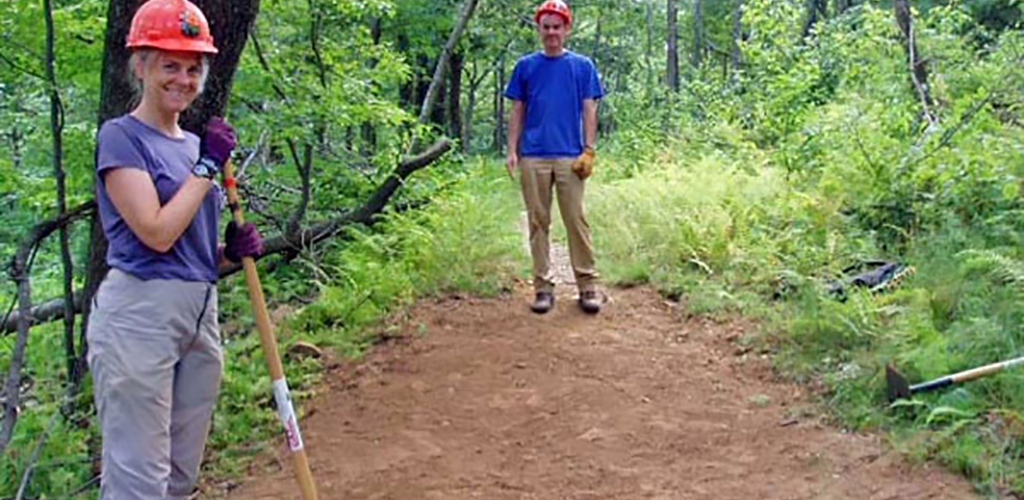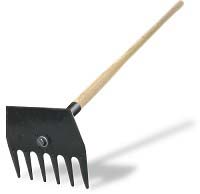Cutting and Filling Tread

A common problem commonly faced by the average Appalachian Trail section overseer involves trail tread that is cupped.
This results from a combination of factors, including:
- Erosion
- Trail design & layout
- Erosion
- Years of foot travel
- Erosion
- Compacted soil
- Erosion
Original Treadway
Nearly 70 years ago, the Civilian Conservation Corps relocated the A.T. to remove it from the route of the new Skyline Drive. In many cases, the CCC crews built cribbing of stone and brought in mineral soil (clay) to top off their cribbing. After millions of footfalls and foot-pounds and gallons of rain water later, the Trail in many areas showed moderate to worse damage.
Trail construction techniques the CCC used dictated a level surface from side-to-side of the trail. The sad fact is, that this technique often results in erosion, as the treadway surface forms a path straight-way downhill. Rain water, like so many other inanimate objects (including students, politicians, zealots of any ilk, and so forth) automatically chooses to follow the Path of Least Resistance. Therefore, the bulk of the tread material—the clay soil—was washed away over the years. That this erosion wasn’t so bad is due mainly to the good grade on which the Trail was built.
The grade was not excessive, but it went up and over the contours instead of working with the topography. Also, the tread itself was not sloped outward, or “out-slopped,” so run-off tended to run down the trail, causing it to become a stream bed. Especially after 70 years of hikers had trod the section.
Start Your McLeods!
 The only real “solution” to this problem is to cut-and-fill the cupped treadway section. This requires you to cut dirt from the uphill section and pull it into the cupped treadway. You will stabilize the tread for a period of time, but it won’t fix the problem permanently. To do that, a crew would need to pull enough dirt out into the trail to form a “lip” over the capstones of the crib wall and grade the tread to at least a 1% grade out to the edge of the capstones. There may not be enough dirt available, in some cases, to do that.
The only real “solution” to this problem is to cut-and-fill the cupped treadway section. This requires you to cut dirt from the uphill section and pull it into the cupped treadway. You will stabilize the tread for a period of time, but it won’t fix the problem permanently. To do that, a crew would need to pull enough dirt out into the trail to form a “lip” over the capstones of the crib wall and grade the tread to at least a 1% grade out to the edge of the capstones. There may not be enough dirt available, in some cases, to do that.
It’s time to introduce our favorite tool for situations like this: the Venerable McLeod.
The McLeod lets you cut duff and mineral soil using the tines, pull the mineral soil (clay) using the straight edge, and grade and tamp it using the flat side of the blade.
Take Care of Cribbing
An interesting thing happened over the 70+ years since the Civilian Conservation Corps built the Appalachian Trail in Shenandoah National Park—erosion. The fact is, that the only evidence you see of any original crib wall is the line of capstones along the outside edge of the trail. The rest of the crib wall lies buried under the soil that washed down off of the ridge and off of the original treadway. In some cases, that soil is gone and hikers walk on the original rock that filled the cribbing.
Theoretically, you could dig soil from the crib wall—if soil is present—and replace it into the treadway. Unfortunately, Mother Nature had other plans for that material: it is no longer mineral soil (that is, clay) but has been transformed into, essentially, topsoil. Trees and shrubs and weeds and Poison Ivy and vine of all descriptions grow in it. It contains a lot of duff, and duff is not good for tread filler. (It compacts and causes more run-off problems too quickly.) Still, maintainre crews can, if needed, pull a significant amount of clay from underneath the duff and place it in the tread. Most of the mineral soil used, of course, comes from cutting the uphill bank and pulling it into the treadway.
Finally…Leaf Litter

Just when the maintainer thinks she or his has finished, there is another job to do—Prevent Splash Erosion!
Splash erosion is the effect of raindrops hitting loosely compacted clay. Each drop falls far to Earth from somewhere Up There. The impact of a single drop is insignificant; however, the cumulative effect of many drops can cause serious problems before the newly re-established tread is fully set.
How to handle this issue? Simple: scatter leaves over the new tread! In eons past, some disgruntled trail crew worker snorted in disgust and claimed that his (or her) Boss wanted him (or her) to litter the trail with leaves. Hence, we know this material as “Leaf Litter.”
 South Shenandoah
South Shenandoah